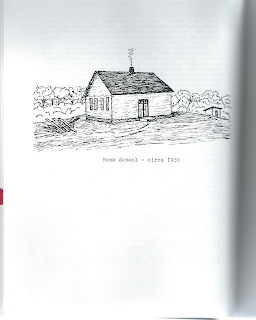Chapter 6
Bona School
By the time we
moved to that little farm south of Bona, Richard and I had attended four or
five different schools ranging from the large Faxon Elementary in Kansas City to
the little grey-weathered one room school, Shady Grove, where we went from Doc
Hunt’s place and where Rex started in the first grade. We attended Bona School from the time we
moved to the big yellow house, then the white house and, finally, the little
three-room house all just south of Bona.
Bona School (also known
as the Lindley School, I guess because the Lindley family had founded it) was
one step beyond the common one-room country school room. Bona School sat on top of a low hill one-mile
north of Bona itself. It was a
three-room “Jobe School” (I do not know why), having grades one through ten so
it was sort of a combination of elementary and junior high school. I would reckon that in “olden days” most farm
kids did not go to school beyond tenth grade.
Bona School was a
white clapboard building built in the shape of a “T.” Across the ront there were two rooms and
added onto the back was a third smaller room.
We referred to the back room as the “Little Room” because that was where
they had grades on through four. The
larger room on the north side of the front was the “Middle Room” with grades
five through eight. The other was the “Big
Room” where there were the older children in grades nine and ten.
To me there was
definite advantage in those country schools with several classes in one room
and where each class went in turn to the front row of seats to recite. Since I usually found the work in my own
grade quite easy, I would often listen in on the lectures of the teacher to the
more advanced classes and then the following year I was familiar with much of the
work. I would often take home school
books to read and study on my own over a weekend just to find out things I
wanted to know—science books and geography in particular because I wanted to
know about the world and everything in it.
I did not care much for history and both mathematics and grammar seemed
to come easy for me.
To get back to
Bona School, each of the rooms had its own coal stove for heat in the
winter. All were connected to a central
brick chimney. The rooms had moveable
wall dividers between them that could be removed for social events, school
plays, and the like. [It seems to me that
schools thought moveable walls were an innovation in the 1970s and ‘80s] The
desks were mounted on boards instead of the floor so that they could all be
rotated to face the little stage that was located at one side of the Middle
Room.
The school did not
have a carbide lighting system like the Bona Church. When we first started there, evening events
were still lighted by coal oil lamps and lanterns; however, about that time the
principal, Mr. Hardesty, raised enough money through pie suppers, etc., that
they could buy six Coleman gasoline lanterns which gave considerably better
light.
Wikipedia describes pie suppers as being an Ozark phenomenon to raise money for schools, but I know for sure that they happened in Oklahoma as well. Young ladies made pies and fixed picnic baskets which were auctioned off to the highest bidder (usually a man) and they ate with them. The money went to the school. I remember my grandmother telling about them being common in her day.

